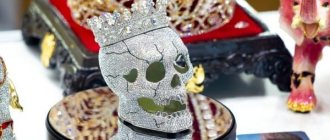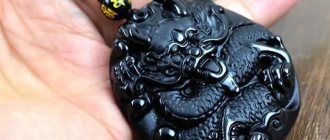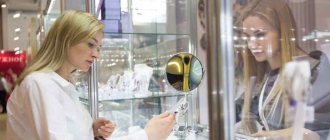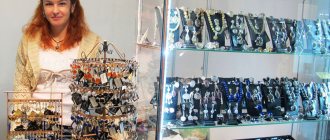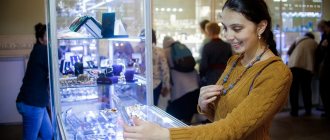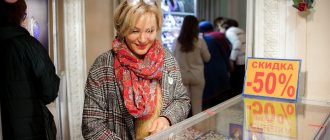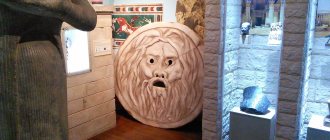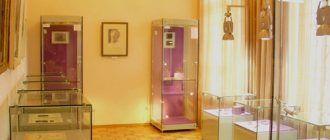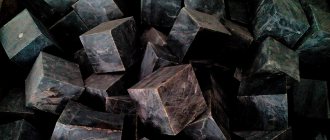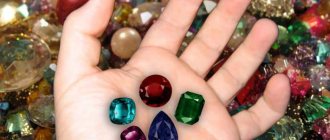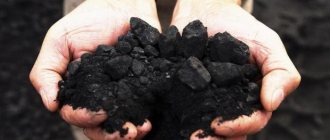The exhibition “Gem Disruption” (more commonly called “Gemma”) is one of the oldest in Moscow. It has been held since 1991 and is constantly “registered” at VDNKh, although it changes pavilions from time to time. On its days, professionals who personally mine minerals, as well as sellers of stones and jewelry made from them, come from all over the country and even other countries.
The exhibitions focus on collections and raw materials (including jewellers). However, here you can also find ready-made jewelry with stones, as well as crafts carved from stone.
Our impressions of the exhibition "Gemma"
The editors of “JEWELIRUM” visited the first fair of 2015 – in April. And this exhibition impressed us, if not shocked us with its diversity and truly miracles extracted from the depths. But what we saw at the stands is a little lower.
This time the exhibition took place in pavilion No. 55, just to the right of the famous “Cosmos”. We didn’t find any minibuses at the main entrance, so we just walked for about 15 minutes around the territory of VDNKh.
After queuing for a bit, we purchased entrance tickets at the price of 100 rubles in the “anteroom” between the glass doors. And finally we found ourselves inside a spacious open rectangular hall, along which there were rows of tables with lamps on.
The first vivid impression of the exhibition was the amazement of the huge number of visitors. There really were a lot of people, and they stood in groups near almost every table, making our photographer’s work much more difficult. We have never met so many guests at any jewelry exhibition. It turned out that minerals attract almost more than finished masterpieces of jewelry:
It was a special pleasure to watch representatives of professional communities involved in the extraction and processing of stones. Special atmosphere and special faces:
Winter "Gemma" - 2022. Photo report from the exhibition
Gemstone Fall exhibitions , held three times a year by the “ Gemma ” gallery, have long turned from just a platform for selling fossils, stones and products made from them into a place where you can communicate with equally enthusiastic people, see unique specimens, and, if you’re lucky, and learn about new interesting deposits. They are held in autumn, winter and early spring. There is no point in doing something like this in the summer: the main interest here is not from the stands of resellers, but from those who actually collect and dissect the samples. You won’t find them in Moscow during the day in the summer: they all disperse to the mountains and mines.
Winter "Gemma" - 2017
In general, the location of the dots and the main background of the samples practically does not change from year to year, but each time it is possible to discover something unique that was not seen at previous exhibitions. This time, for example, there were quite a lot of fish from Pshekha and other points of the Krasnodar Territory , and Russian fossils in general. I was impressed by the selection of agates from historical collections of the sixties near Moscow from the Golutvinsky quarry , equally beautiful and expensive. Trilobites from the Leningrad region were represented in only one place, but they impressed with their diversity and high quality of preparation. There were also interesting examples of stone carvings, paintings made using the Florentine mosaic technique, reconstructions of flint tools - skillfully executed and quite functional.
Reconstructions of primitive tools
Compared to the autumn “Gemma”, I was pleasantly surprised by the lack of crowding around the stands. Apparently, this was sad for sellers (the September exhibition was enough for many potential buyers), but it gave them the opportunity to photograph the most interesting displays calmly and without haste.
There is no point in talking at length about “Gemma”: you have to see it. Therefore, the further story is offered in the form of captions to the photographs.
Fish and algae of the river Pshekha (gray tiles), fish from the vicinity of Red Dagestan (beige tiles), huge brachiopods Gigantoproductus from the Tula region, stromatolites, ammonites from various places and some Carboniferous flora
Corals from the Lower Carboniferous of the Tula region, sponges and Yaroslavl ammonites
Fish prints. North Caucasus, Krasnodar region
Trilobites and cystoids of the Leningrad region
Huge agates and stone carvings
"Princess Frog"
Golutvinsky agates. Historical fees of the 60s
Agates from the Golutvinsky quarry close up
Minerals and stone carving
Flint knives with bone handles and mammoth figurines
The Crystal Parrot watches the "Gem Collapse"
Stone knives for every taste
Variety of agates
Paintings using the Florentine mosaic technique
It will be extremely difficult for a person passionate about minerals and fossils (and there are no others here) to leave the exhibition without “trophies,” regardless of the budget. On the one hand, there is a great risk of spending an arbitrarily large amount (therefore, it is better not to take “extra” money), but on the other hand, you can get very interesting specimens within one hundred to two hundred rubles. Below are the most interesting of our finds from the December “Gemma”.
Grape chalcedony. Sulawesi, Indonesia
Sea bladder Echinospaerites sp. Ordovician Leningrad region, r. Volkhov
Clinochlore
Silurian trilobite Coronocephalus Jastrowi. China
Fluorite. Khurai deposit, Dzhidinsky district, Buryatia
Fluorite. Naranskoye field, Selenginsky district, Buryatia
Split quartz crystal. Dalnegorsk
Ammonite and bivalves. Kaluga region, Lipitsa, r. Serena
“Symphony of Gems”: jewelry and mineralogical exhibition-fair in Moscow
From December 3 to 5, the jewelry and mineralogical exhibition-fair “Symphony of Gems” is taking place in Moscow. At the exhibition you can see private and museum collections, jewelry, stone-cutting sculptures and blacksmith works. Such events have been held for 26 years.
The concrete jungle is in full swing with life: participants are laying out exhibits, sorting minerals into boxes, setting up a lecture hall, and hanging decorations. Among the guests are very young collectors, and old-timers of exhibitions, seekers of rare specimens and lovers of unique jewelry. Experienced geologists, jewelers, artists, amateur collectors, gemologists - their relationship with stone is different, but they are all united by a love of minerals, metals, fossils and rocks.
At the exhibition, a jewelry workshop worked in the field. Its owner was repairing jewelry right in the field, and during the conversation he was laser sealing a silver ring:
“My favorite material is the one I work with - gold and silver,” Alexander Evteev, a jeweler with 16 years of experience, “I don’t process stones in any way. I’ll be honest, in all my years of work I haven’t found that I liked any particular form the most. They're all good. It no longer depends on the shape of the stone, but on the shape of the product itself. That is, some forms can be interesting to make or come up with something new. And the shape of the stone... We start from it and that’s it.”
Another participant in the exhibition was the “Stone Experts” club. In their part of the exhibition, guests could watch films about minerals and listen to popular lectures for novice collectors. The exhibition organizers spoke about their favorites among minerals:
“I am a person who cares about mineralogy. I love it, I love collecting, I love museums, I love the company “Rock Researchers,” said geologist Vsevolod Aristov. “My favorite mineral is corundum. The fact is that it has accompanied me throughout my entire adult life; it is a mineral that I fell in love with as a child. I wrote a thesis about him at the Geological Exploration Institute. Well, in general, samples of this mineral, which I mined with my own hands, are now in foreign museums. Well, it turned out that everything was great, beautiful.”
In addition, Aristov is the head of the “Charming Hedgehogs” club of young geologists and some of them were guests of the exhibition. We managed to catch one “hedgehog” and find out what they are doing:
“I once went on a hike with the guys to excavate a quarry, and I found several interesting samples,” says Margarita Tkacheva, “well, probably my favorite mineral is charoite and rhodonite. I have loved them since childhood. But I’m not really into fossils; ammonites are probably very beautiful. This is my second time at the exhibition; before that I was in September. Like".
These were professionals, but what do amateurs say? The sales consultant at the “Stone Experts” store, Dima, turned out to be a financier with a passion for stones, and especially fossils. Among them, he is more attracted to teeth, bones, hooves, skeletons - in a word, the remains of large ancient vertebrates. Here's what he said about his favorite mineral:
“My favorite mineral is a good question, I thought about it a lot - I like it, obviously, a lot, including because I work here. Probably the coolest and most liked is seraphinite. It's also clinochlore. This is a green cut with radial growth lines, it turns out that it was cut down. Why is it called seraphinite, because some of its inclusions are white, which shimmer in the light, they look like the wings of an angel. Many people have this association, which is why the trade name is seraphinite, but the scientific name is clinochlore. It is mined in Russia, mainly in the Irkutsk region.”
The exhibition will also be open on December 5. And on December 18-19 it will be possible to visit the mineralogical exhibition “Gem Disintegration”, or “Gemma”.
Recycle Group New Nature
The art of two dimensions, the future that is already here, the opportunity to immerse yourself in augmented reality, get acquainted with artificial intelligence and find trees in the jungle playing techno. The super-technological futuristic mystery exhibition New Nature from the famous art duo Recycle Group opens a portal to the future for viewers.
Download the free audio guide
and the Recycle Group AR app to take you on an exciting journey through cybernated landscapes - through the three spaces of the Winzavod.
The exhibition begins at entrance No. 14
(White Workshop and Red Workshop) and continues in the Great Wine Storage (entrance through Angara ) .
Free audio guide
The art duo Recycle Group are trendsetters in the modern art world, laureates of the Kandinsky Prize. The artists have repeatedly represented Russia at the Venice Biennale and twice made it into the TOP 10 of the 49ART rating. Without betraying themselves, in the new project they turn to the recycling of meanings, the study of cultural and visual codes.
This exhibition is a futuristic reflection on new technological systems and the place of living beings within them. Connect to the global mental space, which has become sacred due to the large number of requests. The system will definitely answer you.
To buy a ticket
Red Workshop
The theme of the section in the Red Workshop is “recycling as reincarnation.” The installation “Open Code” (2021) is the artists’ calling card. In the modern version of the high reliefs of the ancient Greek Parthenon, instead of centaurs and lapiths, people and bots converge in an eternal battle. Like Egyptian pharaohs-mummies, users with phones in their hands lie in garbage cans in the form of ancient sarcophagi (series “Sarcophagi”, 2017–2021). And if you walk through the Romanesque-style “Gate” (2012), made from corrugated pipes for electrical cables, you can get to where the souls of righteous users gain digital immortality. Here, two human bodies, in the process of downloading personal information, are stuck on the border between the worlds – the material world and the world of cloud storage (installation “Enlightener 12. Diptych”, 2015).
Uncover the hidden meanings behind Recycle Group's work and access labels and annotations via QR codes.
Bely's workshop
In the Belyi Workshop, Recycle Group artists explore the specifics of “machine vision”, replacing the human gaze with digital code. In the center of the hall here is the work “Zero” (2021). Choose the right position and the colored luminous arch of servers will be reflected in the mirror surface and close. This is the point of beginning and end, everything and nothing, a symbol of the already accomplished transition to the new digital world.
The multimedia installation “Probability” (2021) offers you two options for the development of your future, two doors - blue and red. Scan the QR code in the application and choose which prediction you want to hear from artificial intelligence - negative or positive. AI doesn't read your palm, it studies your individual digital footprint on social media.
The administrator at the entrance will help you get the electronic queue number and get into the prediction room.
Large Wine Storage
You are taken to the augmented reality section. Download the Recycle Group app for Android
or
iOS
.
Several art objects in these rooms can only be interacted with in this way. To connect to free Wi-Fi and find the application, contact your administrator.
Almost the entire space of the Great Wine Storage is occupied by noisy thickets of plastic “Forest of Expired Links” (2021). On each sheet of total thickets there are already inactive transitions to sites printed. The giant stumps of ancient sequoias in this forest are riddled with fragments of a neural network. If you touch their surface, they will play electronic music.
Blocked Content was created by Recycle Group for the 2022 Venice Biennale. Sinners immured in blocks of ice are blocked users. You can only see them through an AR application. They try to take pictures of invisible food, fight for likes and beg to be returned to online activity.
Another AR installation, “Human Template,” shows a representative of the new species Homo Virtualis in its natural habitat – in augmented reality. The artists are trying to analyze the “archaeological culture” of the early 21st century, the era of the “virtual man.” They play with the theme of high ancient art in synthesis with a new digital identity.
You can walk around the hall with “Artificial Dirt” (2021). This work is a metaphor for the digital footprint, the trash we leave on the Internet. Unneeded and forgotten photos, videos and documents in the memory of instant messengers, cloud services and social networks. The production of such “dirt” in the future threatens not only high tariffs for storing information, but also a physical expansion of the areas where servers will be installed.
There is no conflict between nature and technology. Here thought, spirit and knowledge permeate the elements. The organic world and humans get the opportunity to live a full virtual life - a transformation of matter occurs.
To buy a ticket
The New Nature project is the format of the exhibition of the future. Digital technology here is a necessary condition for interacting with a work of art. And you are an active participant in the creative process.
The exhibition was organized by the Vin Center for Contemporary Art with the support of the central exhibition hall “Manege” (St. Petersburg).
